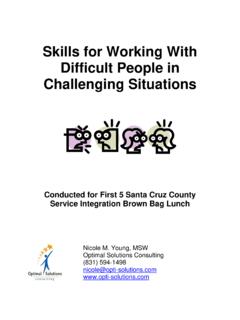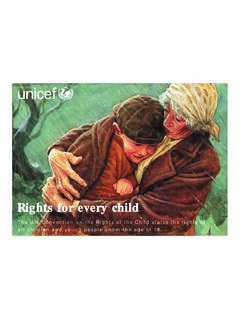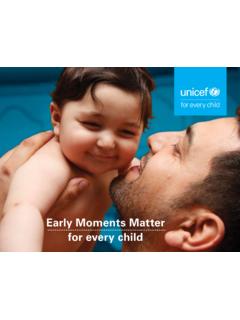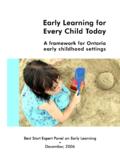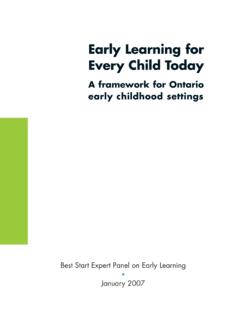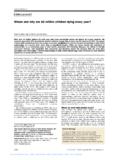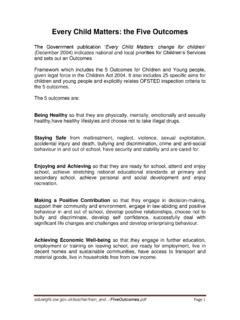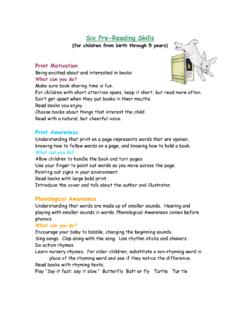Transcription of TOP 10 THINGS EVERY CHILD NEEDS FOR THE BEST START …
1 TOP 10 things every child needs for THE BEST START IN LIFEAt birth, an infant s brain is only 25 percent of the size of an average adult s brain. Incredibly, by 3 years of age, a CHILD s brain has grown to 90 percent of that of an adult. During infancy and early childhood, children are flooded with new experiences that impact their brain development. The first 3 years of a CHILD s life offer parents an amazing opportunity (and accompanying responsibility) to shape their CHILD s growth and form healthy habits that will last a 5 Santa Cruz County has provided parents and caregivers with the following Top 10 THINGS to help give children the best START in #1: Encourage InteractionA CHILD s brain grows based on early experiences at home. The more interactions a CHILD has, the healthier his/her development will Can Parents Do?
2 Respond quickly to your baby s NEEDS Speak in a soft, slow voice Get down to your CHILD s level; involve yourself in your CHILD s play Engage your CHILD in conversation Be present in your CHILD s lifeTip #2: Offer Physical AffectionPhysical affection communicates love to young children, which in turn fosters positive emotional Can Parents Do? Be gentle and responsive to your baby s cues Massage your infant Hold your CHILD when feeding him/her Rock your baby and look into his/her eyes Hold your CHILD on your lap when playing or reading Hug your CHILD oftenTip #3: Provide a Stable Relationship Children who have a stable relationship with at least one caregiver learn at a faster pace, feel better about themselves, and make friends more Can Parents Do? Hold your CHILD on your lap during stressful situations, such as a doctor s visit Be a loving, consistent presence for your CHILD Create an environment that allows your CHILD to explore, but set limits to show both guidance and care Be predictable, nurturing and calm when interacting with your childTip #4: Maintain a Safe, Healthy HomeCreating a safe and healthy home environment allows you to maximize your CHILD s growth with minimal Can Parents Do?
3 CHILD -proof your home Use age-appropriate car seats Be aware of the dangers of lead poisoning found in old paint chips and paint dust Feed your CHILD a healthy, nutritious diet and avoid high-fat foods Visit your CHILD s physician and dentist regularly Ensure your CHILD is up-to-date on immunizations Encourage outdoor play and exerciseTip #5: Develop Strong Self-EsteemA strong sense of self is the foundation for healthy development in young Can Parents Do? Recognize and celebrate that EVERY CHILD is unique from birth Discover who your CHILD is and value his/her identity Encourage your CHILD to express himself/herself Praise your CHILD with concrete positive feedback Respect your CHILD and teach him/her to respect himself/herself and othersTip #6: Choose Quality ChildcareSince childcare settings can be a primary learning environment for children, the quality of the childcare setting is very important.
4 What Can Parents Do? Take an active role in selecting the best childcare for your CHILD Visit the childcare center with your CHILD to determine your CHILD s comfort level Ask yourself these questions when selecting childcare:- Is it a safe, supportive environment?- Do they serve nutritious food?- Do the childcare providers appear to enjoy interacting with the children?- What are the ratios of caregivers to children? Look for the following ratios: 1 caregiver: 3 - 4 children (ages 0 - 3) - Do the adults speak respectfully to the children and encourage them to express their thoughts and feelings?- Are the adults down on the floor playing with the children?- Does the center welcome parental involvement?- Do the children appear happy?Tip #7: Engage in ConversationCommunicating with your CHILD not only shows love, but also encourages the development of his/her speech Can Parents Do?
5 Talk to your baby, early and often Sing to and with your CHILD Use a broad vocabulary to expose your CHILD to many different words Engage your CHILD in conversation Read aloud to your CHILD and ask questions of him/her Tip #8: Promote Play Playing provides children with an outlet for imagination and creativity and fosters healthy brain Can Parents Do? Be your CHILD s playmate, engage in their play Encourage play by using everyday household items in creative ways Get to know your CHILD through playTip #9: Make MusicMusic offers children an outlet for expression and stimulates brain development in specific areas including language and Can Parents Do? Involve your CHILD in music Sing, clap, rock, dance, tap your feet together with your CHILD Encourage your CHILD to make his/her own music using household items Play music in your home and encourage your CHILD to sing and danceTip #10: Make Reading a PriorityReading with children demonstrates a love for books and learning, and is a wonderful way for parents and children to spend quality time together.
6 What Can Parents Do? Read to your CHILD everyday When you read to your CHILD , hold him/her on your lap Point to pictures and ask questions Repeat the same book to help your CHILD make the connection between the written page and the spoken word Write down a story your CHILD tells you show them their words in writingThe first 3 years of life are the most critical in terms of encouraging healthy development. It is important for parents to START as soon as possible to build the foundation that will help their children reach their full potential. The good news is that what EVERY CHILD NEEDS , EVERY parent can give. If we care for our children and give them what they need early in life, their future will be full of extracted from Ten THINGS EVERY CHILD NEEDS DVD, produced by the Robert t.
7 McCormick Tribune Foundatio
